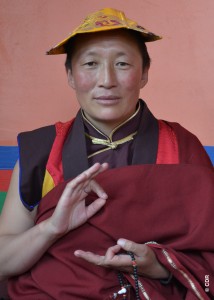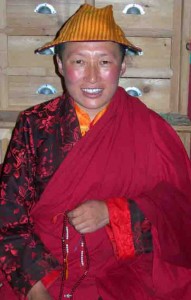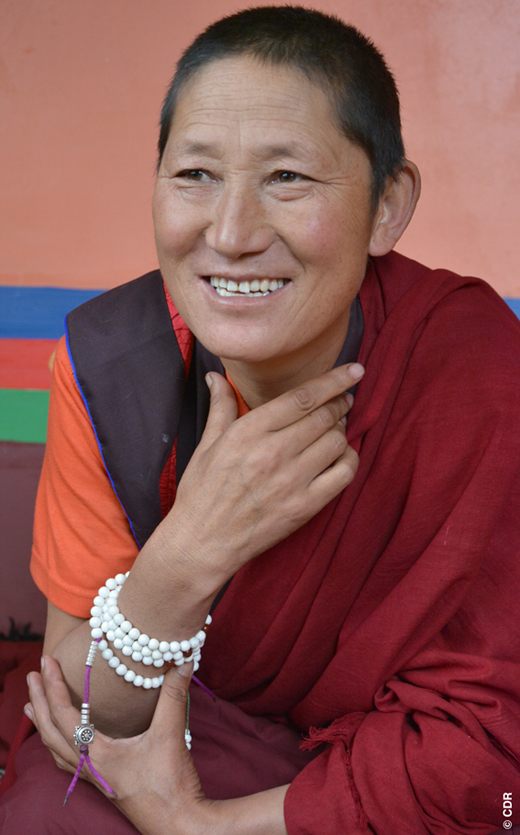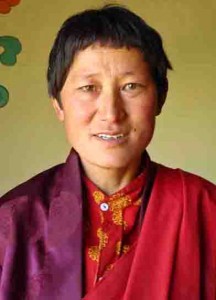Both Urgyen Chodron and Chemchok Palmo are Gebchak nuns and were in their late 30’s at the time of the interview in 2006. Urgyen Chodron is the ritual master that travels to other branch nunneries to teach nuns. Chemchok Palmo is also a ritual master and leads most of the twenty great prayer ceremonies (drubchens[1]) that take place at Gebchak throughout the year. Both nuns are considered by Wangdrak Rinpoche to be very strong practitioners who will become known in the future as “Ani Lamas”.
An interview with Urgyen Chodron, Chemchok Palmo & Wangdrak Rinpoche

Ani Lama Urgyen Chodron with teaching mudra, 2013.
Urgyen Chodron: I came to Gebchak Nunnery when I was 13. I had two older relatives already at the Nunnery – one died at age 95 and the other is Sherab Zangmo[2], who is now about 85. When I was a young girl my parents wanted me to join Gebchak Nunnery, and I wanted to become a nun myself. I knew that I would enjoy being a nun. I have made the promise to stay at Gebchak Nunnery until I die.
When I first came there were about 40 or 50 old nuns with white hair. The previous Ngaksam Rinpoche was here at that time, and well as the old Lama Tenchok. Lama Lodro Wangchuk was here but he passed away in the autumn of my first year at Gebchak. The senior nun Ani Palmo taught all of the nuns the yogic practices of tsa-lung[3], and Sherab Zangmo gave the nuns mind and meditation teachings.
The first practices I did were the 500,000 preliminaries (prostrations, refuge prayer, Vajrasattva, mandalas, and guru yoga). At that time there was no big building for the 16 retreat divisions, each group did their practice in separate little houses. There were about 30 other new nuns doing the preliminary practices with me at the time. For one month we all slept in the two main temples and did our practices there together. After finishing them I became the junior chant master for three years, and then the senior chant master for four years – altogether for seven years. After being the chant master I stayed in Vajrakilaya retreat for seven months, and after that my three-year retreat began. I really enjoyed this time in retreat, I felt very happy. To tell you the truth, I enjoyed being in retreat more than coming out!
There were twenty nuns in the three-year retreat house together. The first year of the retreat was a little difficult because we had to learn all of the chanting and meditation practices. The second year was more enjoyable because I’d become familiar with the meditation practices and my own mind. By the third year I enjoyed the retreat so much. We practiced six sessions every day and night, with almost no breaks except fifteen minutes or so to eat our meals. Throughout the three-year retreat we also did over a million prostrations in between our meditation sessions. We had no boards for these prostrations, we just covered our knees and hands and prostrated on the dirt ground in the basement of the retreat house. Each day we at least did 1000 to 1500 prostrations.

Urgyen Chodron (circa 2006).
At that time there were two retreat houses: one for the Vajrakilaya retreat and the other for the three-year retreat. When the new retreat division building went up the old Vajrakilaya retreat house was torn down and since then a new one hasn’t been rebuilt. Akong Tulku sponsored the new building for the retreat divisions.
My mind transformed while I was in retreat. I didn’t want to come out when the retreat was finished. Although the practices were hard physically, in my mind I was very joyful. Before I did my three-year retreat I had a lot of wild emotions and distractions. But during the retreat these emotions were pacified and transformed into the five wisdoms.
Now my retreat division is Guru Drakpo [Wrathful Guru Padmasambhava]. Every morning from 6 until 8 o’clock each retreat division holds a practice session of meditation and prayers. There is a big room downstairs in the retreat division building where all the nuns do their daily practices of trul-kor[4] and tsa-lung. We have to do these yogic practices everyday throughout our whole lives.
Gebchak Nunnery’s practice of specialty is tsa-lung, and it is practiced here according to the unique teachings of the first Tsang-yang Gyamtso[5]. Tsang-yang Gyamtso wasn’t a scholar, but wrote these practice commentaries from his pure vision and meditative realization.
Wangdrak Rinpoche: Now the Nunnery’s practice lineage is completely in tact. All the practices of tsa-lung, trul-kor, the 20 drubchens, and all the original traditions of the Nunnery have been passed down by the senior nuns to the young nuns. At present they are all being upheld.
Before they enter the three-year retreat the nuns have faith and belief. But during the three-year retreat they practice the Three Roots[6] and the Six Yogas[7], and from their meditative experience they develop a very strong, unshakable faith in the practice.
During the three-year retreat the five negative emotions become transformed, not by rejecting them but by realizing their wisdom nature.

Ani Lama Chemchok, 2013.
Urgyen Chodron: When we are in retreat there are no particular times for meditation; we constantly maintain our practice. We chant along with visualization and contemplation of the meaning, and we meditate on the inseparable prana[8] and mind. During the stage of mantra recitation the lama is visualized above the head, during the stage of accomplishment the lama is at the throat, and during the stage of activities the lama’s mind and one’s own mind merge as one.
…
Question: What are the differences between the practices in the 16 retreat divisions and those in the three-year retreat?
Chemchok Palmo: The yidams [deities] are different, but the practices of trul-kor and tsa-lung and the fundamentals are the same.
If one hasn’t received the transmissions of trul-kor and tsa-lung, you are not allowed to view these yogic practices. If you happen to see them without having received the transmissions, there is a danger that the Dharma protectors will cause harm to your eyes and limbs.
After you’ve received the transmission, teachings, and permission you may practice these yogas. Trul-kor and tsa-lung are hidden, secret teachings.

Chemchock Palmo (circa 2006).
Q: What would be your heart advice to other Buddhists in foreign countries?
Urgyen Chodron: Have faith in the lama, have belief and certainty in the lama’s instructions, have the compassionate mind to benefit all other beings, and have renunciation of samsara.
Chemchok Palmo: Abandon harming others.
Q: Do you pray to be reborn in a male body in your next life?
Chemchok Palmo: There is no male or female in enlightenment. Once you’re a Dharma practitioner it is joyful and there is no difference for monks or nuns. I don’t think that a fully ordained monk is superior and I’m worse off. I just think that accomplishing the Dharma is joyful.
In the past there have been nuns at Gebchak Nunnery who have attained the rainbow body. Gebchak is a particular place for women to accomplish the Dharma. Here is a well known story: Many years ago at the place called Kilakar some lamas were giving a Dharma teaching to the nuns. Two older nuns named Tendron and Yendron were in retreat some distance away at Gyarong. From their hermitage they took on forms as small birds and flew to Kilakar to receive the teachings. They flew around the lamas and with their beaks they tugged at the lamas’ ears. The lamas knew who they were. These two nuns later attained rainbow bodies.
Q: At that time how many Gebchak nuns were there?
Urgyen Chodron: There were many. And many nuns could miraculously cross the Kyichu River without need of a bridge. These miracles came through the yogic accomplishments of the Sang Tri Rig Nga[9]– such as emanating from the state of dream yoga.

Wangdrak Rinpoche & Chemchok Palmo at Gebchak Nunnery.
Wangdrak Rinpoche: Gebchak Nunnery must seem like another planet to these visitors! You can see the meditation practices and bodhicitta here are very good. Please introduce Gebchak Nunnery to others and tell them what you’ve seen and heard here.
Urgyen Chodron: During the winter there is not even one day break, we are continuously staying in drubchens. Besides these 20 drubchens we also have various other ritual ceremonies for removing obstacles.
Q: What are the benefits of these drubchens?
Wangdrak Rinpoche: We begin each drubchen by going for Refuge to the Three Jewels and contemplating the Four Immeasurables. Then is the main practice of generating the deity, followed by mantra recitation along with the inner, outer and secret visualizations. We make many offerings to the Three Jewels, and at the end of the drubchen we make a proper dedication of the merits for the temporary and ultimate happiness of all sentient beings. In this way we are accumulating merit and wisdom and accomplishing the three bodies of a buddha. All the chanting of the drubchens is performed together with contemplation of the meaning.
Chemchok Palmo: It is said that Gechak Nunnery is a second Zangdog Palri[10]. Whoever sees the Nunnery and witnesses the practice here feels joy. Even hearing about it brings joy. Coming here is like taking the first step towards buddhahood.
[1] drubchen: Great accomplishment practice; a sadhana practice undertaken by a group of people which goes on uninterruptedly for seven or more days.
[2] Sherab Zangmo was a highly accomplished nun who was known as the Nunnery’s “Ani Lama”. Read more.
[3] tsa-lung: the inner yoga of psychic channels and energies.
[4] trul-kor: hatha yoga style methods which prepare for the inner yoga of psychic channels and energies.
[5] Tsang-Yang Gyamtso: the founder of Gebchak Nunnery. The first Tsang-Yang Gyamtso was a heart disciple of the first Drubwang Tsoknyi Rinpoche.
[6] Three Roots: guru, yidam (personal meditational deity), and dakini.
[7] Six Yogas: Six Yogas of Naropa: tummo, illusory body, dream yoga, clear light, bardo, and phowa
[8] prana: the wind element; vital energy.
[9] Sang Tri Rig Nga: the inner yogas of nadi, prana and bindu according to the revealed treasure of Ratna Lingpa.
[10] Zangdog Palri: the Glorious Copper-colored Mountain; the pure land of Guru Rinpoche.
Note: Interview conducted in July, 2006, at Gebchak Gonpa, and translated by Tenzin Chozom.
- Read next interview.>>
- Back to Gebchak nuns.
